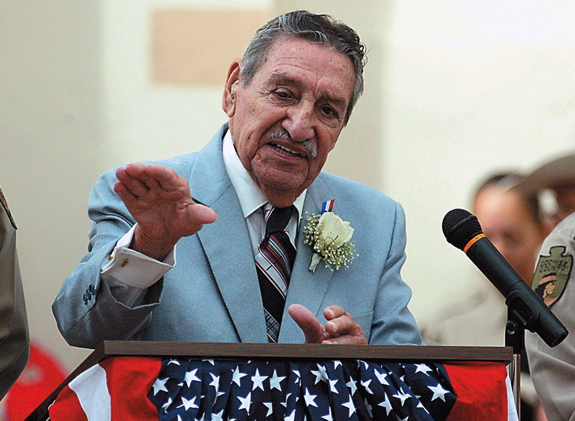Raul Hector Castro, ambassador and Arizona governor, dies at 98
April 14, 2015 - The Washington Post
By Paul Davenport April 14
Raul Hector Castro, Arizona's only Hispanic governor and a U.S. ambassador to three countries, died April 10 in San Diego, where he was in hospice care. He was 98.
Family spokesman James Garcia announced the death. The cause was not disclosed.
Mr. Castro overcame poverty and discrimination to graduate from college and launch a successful career in politics and diplomacy.
Growing up on the U.S.-Mexico border near Douglas, Ariz., he saw discrimination around him. He said he wondered why the Hispanics were laborers and none delivered the mail or worked in offices.
It didn't seem right that Hispanic children had to walk miles to school every day while white children would wave from a passing school bus, he said.
 (left) Raul Hector Castro, former governor of Arizona and former U.S. ambassador to El Salvador and Argentina [and Bolivia], in 2006. (Ed Honda/AP)
(left) Raul Hector Castro, former governor of Arizona and former U.S. ambassador to El Salvador and Argentina [and Bolivia], in 2006. (Ed Honda/AP)
He set out to beat the odds. When he couldn't get a job as a teacher — schools didn't hire educators of Mexican descent back then — he became a drifter for a while, working as a farm hand and boxer.
He landed a job with the U.S. consulate in the border city of Agua Prieta, Mexico. After five years, a senior official told him he was doing a great job but had no future in the Foreign Service because he had a Hispanic name and no Ivy League education. Mr. Castro quit and moved to Tucson.
Discouraged from attending law school by a dean at the University of Arizona, Mr. Castro went to the university's president, who persuaded the dean to give Castro an opportunity to prove himself. He excelled and was elected the first Hispanic county attorney and later the first Hispanic judge in Pima County Superior Court.
Raul Hector Castro was born June 12, 1916, in Cananea, Mexico, about 30 miles south of the Arizona border. His father, a union leader forced out of Mexico for organizing a strike at a mine, died when the younger Mr. Castro was 12. His mother became a midwife to feed the family.
Mr. Castro, the second-youngest of 12 children, grew up mostly in Douglas, Ariz. He graduated in 1939 from what is now Northern Arizona University, where he was a member of the track and boxing teams.
He went on to serve as ambassador to three Latin American countries under three U.S. presidents. President Lyndon B. Johnson sent him to El Salvador, where Castro became known as "Yankee Castro" to differentiate him from the other Raul Castro — the brother of Cuban dictator Fidel Castro.
Johnson later sent him to Bolivia, and he stayed for a short time under President Richard M. Nixon before returning to Arizona and making the first of two bids for governor.
He lost to Republican Jack Williams in 1970 but fared better four years later, defeating Republican Russ Williams.
Mr. Castro was governor for 2½ years before resigning when President Jimmy Carter appointed him ambassador to Argentina.
"The thing that bothered me the most when I resigned as governor, the Hispanic community felt that I had betrayed them because they worked so hard to get me elected," he said decades later. "I had to convince them and persuade them that being an American ambassador was just as important as being a governor. I had more authority."
Mr. Castro spent his waning years in Nogales, Ariz., talking to students across the state.
Survivors include his wife, Pat Castro, and two daughters.
— Associated Press